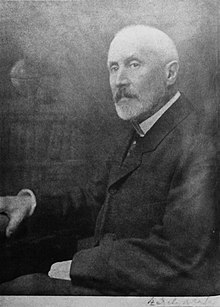Baron Loránd Eötvös de Vásárosnamény (or Loránd Eötvös, pronounced [ˈloraːnd ˈøtvøʃ], Hungarian: vásárosnaményi báró Eötvös Loránd Ágoston; 27 July 1848 – 8 April 1919), also called Baron Roland von Eötvös in English literature,[2] was a Hungarian physicist. He is remembered today largely for his work on gravitation and surface tension, and the invention of the torsion pendulum.
In addition to Eötvös Loránd University[3] and the Eötvös Loránd Institute of Geophysics in Hungary, the Eötvös crater on the Moon,[4] the asteroid 12301 Eötvösand the mineral lorándite also bear his name.
Loránd Eötvös | |
|---|---|
 Eötvös in 1912 | |
| Born | 27 July 1848 |
| Died | 8 April 1919 (aged 70) |
| Nationality | Hungarian |
| Alma mater | University of Heidelberg |
| Known for | Eötvös experiment Eötvös rule Eötvös pendulum |
| Spouse(s) | Gizella Horvát |
| Children | Jolán Rolanda Ilona |
| Parent(s) | József Eötvös Agnes Rosty de Barkócz |
| Scientific career | |
| Fields | Physics |
| Institutions | University of Budapest |
| Doctoral advisor | Hermann Helmholtz[1] |
https://en.wikipedia.org/wiki/Loránd_Eötvös
No comments:
Post a Comment